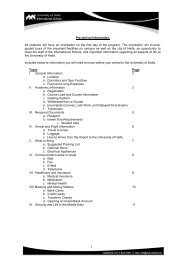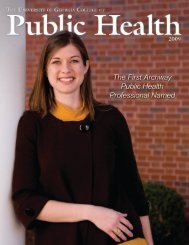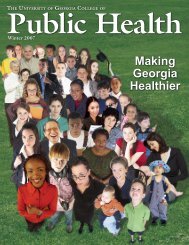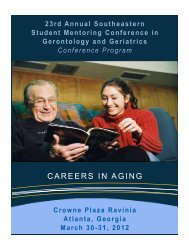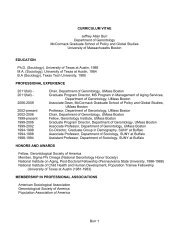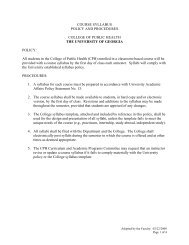Marsha Davis, Ph.D. Associate Professor Department of Health ...
Marsha Davis, Ph.D. Associate Professor Department of Health ...
Marsha Davis, Ph.D. Associate Professor Department of Health ...
Create successful ePaper yourself
Turn your PDF publications into a flip-book with our unique Google optimized e-Paper software.
<strong>Marsha</strong> <strong>Davis</strong>, <strong>Ph</strong>.D.<strong>Associate</strong> <strong>Pr<strong>of</strong>essor</strong><strong>Department</strong> <strong>of</strong> <strong>Health</strong> Promotion and BehaviorCollege <strong>of</strong> Public <strong>Health</strong>University <strong>of</strong> GeorgiaAthens, GA 30602E-mail: davism@uga.eduTelephone: 615.352.4369Areas <strong>of</strong> SpecializationDesigning, implementing, and evaluating community-based health promotion programs;behavioral epidemiology; behavioral science theory; program evaluation; grouprandomizedtrial methodologies; measurement <strong>of</strong> health behaviors; psychometricsEducation1974-1977 Duke UniversityDurham, North CarolinaAngier B. Duke ScholarFellow, Oxford UniversityA.B., Psychology1979-1981 Teachers College, Columbia UniversityNew York, New YorkM.A., Educational Psychology1982-1987 University <strong>of</strong> MinnesotaMinneapolis, MinnesotaPre-doctoral Fellow (National Heart, Lung and Blood Institute)Behavioral Epidemiology<strong>Ph</strong>.D., Educational Psychology and Behavioral Epidemiology1987-1990 University <strong>of</strong> MinnesotaMinneapolis, MinnesotaPost-doctoral Fellow (National Heart, Lung and Blood Institute)Behavioral Epidemiology
<strong>Marsha</strong> <strong>Davis</strong>, <strong>Ph</strong>.D. Page 2Pr<strong>of</strong>essional Appointments2006-present<strong>Associate</strong> <strong>Pr<strong>of</strong>essor</strong><strong>Department</strong> <strong>of</strong> <strong>Health</strong> Promotion and BehaviorCollege <strong>of</strong> Public <strong>Health</strong>, University <strong>of</strong> GeorgiaAdjunct <strong>Associate</strong> <strong>Pr<strong>of</strong>essor</strong><strong>Department</strong> <strong>of</strong> Foods and NutritionCollege <strong>of</strong> Family and Consumer Science, University <strong>of</strong> Georgia2002-20062002-2005<strong>Associate</strong> <strong>Pr<strong>of</strong>essor</strong>, <strong>Department</strong> <strong>of</strong> Human and Organizational Development,Vanderbilt University, Peabody CollegeProgram Chair, Human, Organizational and Community Development Master’sProgram1998-2002 <strong>Associate</strong> <strong>Pr<strong>of</strong>essor</strong>, Division <strong>of</strong> Epidemiology, School <strong>of</strong> Public <strong>Health</strong>,University <strong>of</strong> MinnesotaProgram Chair, Maternal and Child <strong>Health</strong>1996-1998 <strong>Associate</strong> <strong>Pr<strong>of</strong>essor</strong>, <strong>Department</strong> <strong>of</strong> Nutrition, College <strong>of</strong> <strong>Health</strong> and HumanSciences, Georgia State University<strong>Associate</strong> <strong>Pr<strong>of</strong>essor</strong>, Center for Applied Research, College <strong>of</strong> Policy Studies,Georgia State University1990-1996 Assistant <strong>Pr<strong>of</strong>essor</strong>, <strong>Department</strong> <strong>of</strong> Behavioral Sciences and <strong>Health</strong> Education,The Rollins School <strong>of</strong> Public <strong>Health</strong>, Emory University1990-1996 Assistant <strong>Pr<strong>of</strong>essor</strong>, Winship Cancer CenterSchool <strong>of</strong> Medicine, Emory University1987-1990 Postdoctoral Fellow, Behavioral Aspects <strong>of</strong> Cardiovascular Disease, NationalHeart, Lung and Blood Institute, University <strong>of</strong> Minnesota1982-1987 Predoctoral Fellow, Behavioral Aspects <strong>of</strong> Cardiovascular Disease, NationalHeart, Lung and Blood Institute, University <strong>of</strong> Minnesota1981-1982 Policy Analyst, Social Science Operations Center, Advanced Technology, Inc.,Reston, Virginia1978-1981 Research <strong>Associate</strong>, The College Board, New York, New York
<strong>Marsha</strong> <strong>Davis</strong>, <strong>Ph</strong>.D. Page 3Research Grants2008-present2008-present2006-present2006-presentCo-Investigator, Translating a Weight Management Program to Worksites.National Institute for Occupational Safety and <strong>Health</strong>, Centers for DiseaseControl and Prevention, U.S. Public <strong>Health</strong> Service. University <strong>of</strong> Georgia,Athens, GACo-Investigator, Evaluation <strong>of</strong> Abstinence Based Programs, Subcontract toGeorgia Communities in Schools. University <strong>of</strong> Georgia, Athens, GACo-Principal Investigator, Taking National Nutrition Policy to Scale:Evaluating <strong>Health</strong>-Policy Implementation within an Urban School System.Robert Wood Johnson Foundation. Atlanta Public Schools, Atlanta, GACo-Principal Investigator, Director <strong>of</strong> Evaluation, Evaluation TechnicalAssistance to Community Programs Providing Nutrition and <strong>Ph</strong>ysical Activityfor Children. <strong>Health</strong>care Georgia. University <strong>of</strong> Georgia, Athens, GA2002-2008 Principal Investigator, Improving Diets <strong>of</strong> Preschool Children and TheirFamilies. National Cancer Institute. University <strong>of</strong> Georgia, Athens, GA2000-2004 Co-Principal Investigator, <strong>Health</strong>y Generations. United States <strong>Department</strong> <strong>of</strong>Agriculture. University <strong>of</strong> Georgia, Athens, GA.2000-2002 Co-Principal Investigator, Program Evaluation Assistance Center for theMinnesota Community-Based Tobacco Prevention Programs. Minnesota<strong>Department</strong> <strong>of</strong> <strong>Health</strong>. University <strong>of</strong> Minnesota, Minneapolis, MN.2000-2002 Co-Investigator, Study <strong>of</strong> Tobacco Diversion Programs in Minnesota, MinnesotaPartnership for Action Against Tobacco. University <strong>of</strong> Minnesota, Minneapolis,MN.1999-2002 Co-Investigator, Leadership Education in Maternal and Child Public <strong>Health</strong>.Maternal and Child <strong>Health</strong> Bureau. University <strong>of</strong> Minnesota, Minneapolis, MN.1999-2002 Co-Investigator, Weight Gain Prevention in African American PreadolescentGirls--Field Center. National Heart, Lung, and Blood Institute. University <strong>of</strong>Minnesota, Minneapolis, MN.1999-2002 Co-Investigator, Director <strong>of</strong> Evaluation, 5 a Day Cafeteria Power Plus. NationalCancer Institute. University <strong>of</strong> Minnesota, Minneapolis, MN. Subcontract toMinnesota <strong>Department</strong> <strong>of</strong> <strong>Health</strong>, Minneapolis, MN.
<strong>Marsha</strong> <strong>Davis</strong>, <strong>Ph</strong>.D. Page 41999-2002 Co-Investigator, Methods Study <strong>of</strong> a Computerized Statewide ProcessEvaluation System. University <strong>of</strong> Minnesota, Minneapolis, MN.1995-2000 Principal Investigator, Nutrition Intervention for Families through Schools.National Cancer Institute. University <strong>of</strong> Minnesota, Minneapolis, MN.1996-1998 Co-Investigator, Director <strong>of</strong> Evaluation. Dietary Intervention in Black Churches.National Cancer Institute. Emory University, Atlanta, Georgia.1995-1998 Co-Principal Investigator, Director <strong>of</strong> Evaluation. Prevention <strong>of</strong> PediatricObesity. Woodruff Foundation. Emory University, Atlanta, Georgia.1995-1997 Co-Investigator, Director <strong>of</strong> Evaluation. Project Excellence: Drug AbusePrevention. Centers for Substance Abuse Prevention. Emory University,Atlanta, Georgia.1995-1997 Principal Investigator, Director <strong>of</strong> Evaluation, Evaluation <strong>of</strong> Lottery FundedEducational Programs, HOPE Scholarship Program: Analysis <strong>of</strong> high schoolstudents’ educational plans, aspirations, and health behaviors. Georgia StateUniversity, Atlanta, Georgia.1995-1997 Principal Investigator, Gimme 5: Fruits and Vegetables for Fun and <strong>Health</strong>.Subcontract to M.D. Anderson Cancer Research Center. National CancerInstitute. Emory University, Atlanta, Georgia.1995-1997 Co-Investigator, Director <strong>of</strong> Evaluation. Families and HIV Prevention.National Institute <strong>of</strong> Mental <strong>Health</strong>. Emory University, Atlanta, Georgia.1993-1995 Co-Investigator. Director <strong>of</strong> Evaluation, Psychometrics, and EpidemiologicMethods, Gimme 5: Fruits and Vegetables for Fun and <strong>Health</strong>. National CancerInstitute. Emory University, Atlanta, Georgia.1992-1995 Co-Investigator. Director <strong>of</strong> Evaluation, Psychometrics, and EpidemiologicMethods, Teacher Worksite Wellness for Elementary Student <strong>Health</strong>. NationalHeart, Lung and Blood Institute. Emory University, Atlanta, Georgia.1992-1995 Co-Investigator, Lead Behavioral Scientist, Women's <strong>Health</strong> Trial: FeasibilityStudy in Minority Populations. National Cancer Institute. Emory University,Atlanta, Georgia.1992-1994 Co-Investigator for Evaluation, Data-Based Cancer Control in Georgia. Georgia<strong>Department</strong> <strong>of</strong> Human Resources. Emory University, Atlanta, Georgia.1992-1993 Co-Investigator, Director <strong>of</strong> Evaluation, Agromedicine Training Program.Kellogg Foundation. Emory University, Atlanta, Georgia.
<strong>Marsha</strong> <strong>Davis</strong>, <strong>Ph</strong>.D. Page 51992 Co-Investigator, Director <strong>of</strong> Survey Design, Instrument Development,Evaluation, Analytic Methods, Metro Atlanta and Rural Georgia SEER Program.National Cancer Institute. Emory University, Atlanta, Georgia.1991-1992 Program Evaluation Specialist, Intergovernmental Personnel Agreement,Centers for Disease Control and Prevention, National Center for ChronicDisease Prevention, Division <strong>of</strong> Nutrition. Emory University, Atlanta, Georgia.PublicationsBook ChaptersWilson, MG, Baker, K, DeJoy, DM, Bowen, HM, & <strong>Davis</strong>, M. (In press). Theemployer’s role in reducing health disparities through diabetes prevention and control. InL. Jack (Ed.). Diabetes in black America: Public health and clinical solutions to anational crisis.<strong>Davis</strong> M, Baranowski T, Hughes M, Warneke C, deMoor C, Mullis R. (2002). Usingchildren as change agents to increase fruit and vegetable consumption among lowerincomeAfrican American parents: Process evaluation results <strong>of</strong> the Bringing it Homeprogram. In Steckler, A and Linnan, L (eds.) Process Evaluation in Public <strong>Health</strong>Interventions, 249-267. San Francisco: Jossey-Bass.Baranowski T and <strong>Davis</strong> Hearn M. (1997). <strong>Health</strong> behavior interventions with families.In Gochman, DS. (ed.). Handbook <strong>of</strong> <strong>Health</strong> Behavior Research IV: Relevance forPr<strong>of</strong>essionals and Issues for the Future, 303-323. New York: Plenum.Perry CL, Hearn MD, Kelder SH. (1990). The Minnesota Heart <strong>Health</strong> Program YouthProgram. In Nutbeam, D (ed.). Youth <strong>Health</strong> Promotion: From Theory to Practice inSchool and Community, 254-276. London: Forbes.Journal Articles (all peer-reviewed)Beech BM, Kumanyika SK, Baranowski T, <strong>Davis</strong> M, Robinson T, Sherwood NE, TaylorWC, Relyea G, Zhou, A, Pratt C, Owens AS,Thompson N. (2004). Parental culturalperspectives in relation to weight-related behaviors and concerns <strong>of</strong> African-Americangirls. Obesity Research, 12S:7S-19S.Adkins S, Sherwood NE, Story M, <strong>Davis</strong> M. (2004). <strong>Ph</strong>ysical activity among African-American girls: The role <strong>of</strong> parents and the home environment. Obesity Research,12S:38S-45S.Perry C, Bishop D, Taylor G, <strong>Davis</strong> M, Story M, Gray C, Bishop S, Mays R, Lytle L,Harnack L. (2004). A randomized school trial <strong>of</strong> environmental strategies to encouragefruit and vegetable consumption among children. <strong>Health</strong> Education and Behavior,31(1):65-76.
<strong>Marsha</strong> <strong>Davis</strong>, <strong>Ph</strong>.D. Page 6Story M, Sherwood NE, Himes JH, <strong>Davis</strong> M, Jacobs DR, Cartwright Y, Smyth M,Rochon J. (2003). An after-school obesity prevention program for African-Americangirls: The Minnesota GEMS pilot study. Ethnicity and Disease, 13:S54-S64.Sherwood NE, Story M, Beech B, Klesges L, Mellin A, Neumark-Sztainer D, <strong>Davis</strong> M.(2003). Body image perceptions and dieting among African-American pre-adolescentgirls and parents/caregivers. Ethnicity and Disease, 13:200-207.Sherwood N, Story M, Neumark-Sztainer D, Adkins S, <strong>Davis</strong> M. (2003). Developmentand implementation <strong>of</strong> a visual card-sorting technique for assessing food and activitypreferences and patterns in African American girls. Journal <strong>of</strong> the American DieteticAssociation, 103:1473-1479.Warneke C, <strong>Davis</strong> M, Baranowski T. (2001). A 7-item versus 31-item food frequencyquestionnaire for measuring fruit, juice, and vegetable intake among a predominantlyAfrican-American population. Journal <strong>of</strong> the American Dietetic Association,101(7):774-779.Yaroch A, Resnicow K, <strong>Davis</strong> M, <strong>Davis</strong> A, Smith M, Kettle-Khan L. (2000).Development <strong>of</strong> a modified picture-sort food frequency questionnaire administered tolow-income, overweight, African-American adolescent girls. Journal <strong>of</strong> the AmericanDietetic Association, 100(9):1050-1056.Resnicow K, Wallace DC, Jackson A, DiGirolamo A, Odom E, Wang T, Dudley W,<strong>Davis</strong> M, Mitchell D, Baranowski T. (2000). Dietary change through African Americanchurches: Baseline results and program description <strong>of</strong> the Eat for Life trial. Journal <strong>of</strong>Cancer Education, 15(3):156-163.<strong>Davis</strong> M, Baranowski T, Resnicow K, Baranowski J, Doyle C, Smith M, Wang T, YarochA, Hebert D. (2000). Gimme 5 Fruit and Vegetables for Fun and <strong>Health</strong>: Processevaluation. <strong>Health</strong> Education & Behavior, 27(2):167-176.Baranowski T, <strong>Davis</strong> M, Resnicow K, Baranowski J, Doyle C, Lin L, Smith M, Wang T.(2000). Gimme 5 Fruit, Juice, and Vegetables for Fun and <strong>Health</strong>: Outcome evaluation.<strong>Health</strong> Education & Behavior, 27(1):96-111.Cullen K, Baranowski T, Baranowski J, Hebert D, deMoor, C, <strong>Davis</strong> Hearn M, ResnicowK. (1999). Influence <strong>of</strong> school organizational characteristics on the outcomes <strong>of</strong> a schoolhealth promotion program. Journal <strong>of</strong> School <strong>Health</strong>, 69(9):376-380.
<strong>Marsha</strong> <strong>Davis</strong>, <strong>Ph</strong>.D. Page 7Coates R, Bowen D, Kristal AR, Feng Z, Oberman A, Hall D, George V, Lewis CE,Kestin M, <strong>Davis</strong> M, Evans M, Grizzle J, Clifford C. (1999). The Women's <strong>Health</strong> TrialFeasibility Study in Minority Populations: Changes in dietary intakes. American Journal<strong>of</strong> Epidemiology, 149(12):1104-1112.<strong>Davis</strong> Hearn M, Baranowski T, Baranowski J, Doyle C, Smith M, Lin L, Resnicow K.(1998). Environmental influences on dietary behavior among children: Availability andaccessibility <strong>of</strong> fruits and vegetables enable consumption. Journal <strong>of</strong> <strong>Health</strong> Education,29(1):26-32.Resnicow K, Smith M, Baranowski T, Baranowski J, Vaughan R, <strong>Davis</strong> M. (1998).2-year tracking <strong>of</strong> children’s fruit and vegetable intake. Journal <strong>of</strong> the American DieteticAssociation, 98(7):785-789.Resnicow K, <strong>Davis</strong> M, Smith M, Baranowski T, Lin L, Baranowski J, Doyle C, WangDT. (1998). Results <strong>of</strong> the TeachWell worksite wellness program. American Journal <strong>of</strong>Public <strong>Health</strong>, 88(2):250-257.Resnicow K, <strong>Davis</strong> M, Smith M, Lazarus A, Baranowski T, Baranowski J, Doyle C,Wang DT. (1998). How best to measure implementation <strong>of</strong> school health curricula: Acomparison <strong>of</strong> three measures. <strong>Health</strong> Education Research, Theory & Practice,13(2):239-250.Baranowski T, Smith M, Newman M, <strong>Davis</strong> Hearn M, Lin L, Baranowski J, Doyle C,Wang DT, Resnicow K. (1998). Adult consumption <strong>of</strong> fruit and vegetables and fatrelated practices by meal and day. American Journal <strong>of</strong> <strong>Health</strong> Promotion, 12(3):162-165.Resnicow K, <strong>Davis</strong> Hearn M, Smith M, Baranowski T, Lin L, Baranowski J, Doyle C,Wang DT. (1997). Social-cognitive predictors <strong>of</strong> fruit and vegetable intake in children.<strong>Health</strong> Psychology, 16(3):272-276.Baranowski T, Lin L, Wetter D, Resnicow K, <strong>Davis</strong> Hearn M. (1997). Theory asmediating variables: Why aren’t community interventions working as desired? Annals <strong>of</strong>Epidemiology, 7(S7):S89-S95.Baranowski T, Smith M, <strong>Davis</strong> Hearn M, Lin L, Baranowski J, Doyle C, Resnicow K,Wang DT. (1997). Patterns in children’s fruit and vegetable consumption by meal andday <strong>of</strong> the week. Journal <strong>of</strong> the American College <strong>of</strong> Nutrition, 16(3):216-223.Baranowski T, Smith M, Baranowski J, Wang DT, Doyle C, Lin L, <strong>Davis</strong> Hearn M,Resnicow K. (1997). Low validity <strong>of</strong> a seven-item fruit and vegetable food frequencyquestionnaire among third-grade students. Journal <strong>of</strong> the American Dietetic Association,97(1):66-68.
<strong>Marsha</strong> <strong>Davis</strong>, <strong>Ph</strong>.D. Page 8Baranowski T, Baranowski J, Doyle C, Wang DT, Smith M, Lin L, <strong>Davis</strong> Hearn M,Resnicow K, Thompson WO. (1997). Toward reliable estimation <strong>of</strong> servings <strong>of</strong> fruit andvegetables and fat practices from adults’ 7-day food records. Journal <strong>of</strong> NutritionEducation, 29:321-326.Resnicow K, Hearn M, Delano R, Conklin T, Orlandi M, Wynder E. (1997).Development <strong>of</strong> a nutrition knowledge scale for elementary school students: Toward anational surveillance system. Journal <strong>of</strong> <strong>Health</strong> Education, 28(3):156-164.Resnicow K, Vaughan R, Futterman R, Weston R, Royce J, Parms C, <strong>Davis</strong> Hearn M,Smith M, Freeman H, Orlandi M. (1997). A self-help smoking cessation program forinner-city African Americans: Results from the Harlem <strong>Health</strong> Connection Project.<strong>Health</strong> Education Quarterly, 24(2): 201-217.Lusthaus J, Baranowski T, Lin L, Smith M, Baranowski J, <strong>Davis</strong> Hearn M. (1996).Adiposity, fat patterning, and blood pressure among children from two ethnic groups.Cardiovascular Risk Factors, 6(4):233-239.Baranowski T, <strong>Davis</strong> Hearn M, Baranowski J, Lin L, Doyle C, Wahlay N, Treiber F,Thompson W. (1995). TeachWell: The relation <strong>of</strong> teacher wellness to elementarystudent health and behavior outcomes: Baseline subgroup comparisons. Journal <strong>of</strong><strong>Health</strong> Education, 26S(2):1-11.Hearn MD, Bigelow C, Nader P, Stone E, Johnson C, Parcel G, Perry C, Luepker R.(1992). Involving families in cardiovascular health promotion: The CATCH FeasibilityStudy. Journal <strong>of</strong> <strong>Health</strong> Education, 23(1):22-31.Hearn MD, Prokhorov A, Murray DM, Alexandrov A, Luepker R. (1991). Comparison <strong>of</strong>smoking prevalence in school students sampled from the United States <strong>of</strong> America andUnion <strong>of</strong> Soviet Socialist Republics. International Journal <strong>of</strong> Epidemiology, 20(2):413-415.<strong>Davis</strong>on M and Hearn MD. (1989). Two-dimensional configuration <strong>of</strong> unidimensionalstimulus sets in nonmetric multidimensional scaling. Applied PsychologicalMeasurement, 13(4):329-334.Hearn MD, Murray DM, Luepker R. (1989). Hostility, coronary heart disease, and totalmortality: A 33-year follow-up study <strong>of</strong> university students. Journal <strong>of</strong> BehavioralMedicine, 12(2):105-121.Perry C, Luepker R, Murray DM, Hearn MD, Halper A, Dudovitz B, Maile MC, SmythM. (1989). Parent involvement with children's health promotion: A one-year follow-up<strong>of</strong> the Minnesota Home Team. <strong>Health</strong> Education Quarterly, 16(2):171-180.
<strong>Marsha</strong> <strong>Davis</strong>, <strong>Ph</strong>.D. Page 9Murray DM, <strong>Davis</strong> Hearn M, Goldman A, Pirie P, Luepker R. (1988). Four- and five-yearfollow-up results from four seventh-grade smoking prevention strategies. Journal <strong>of</strong>Behavioral Medicine, 11(4):395-405.Murray DM, Perry CL, <strong>Davis</strong> Hearn M. (1987). Cardiovascular risk reduction in children.Education and Treatment <strong>of</strong> Children, 10(1):48-57.Murray DM, Luepker R, Pirie P, Grimm R, Bloom E, <strong>Davis</strong> M, Blackburn H. (1986).Systematic risk factor screening and education: A community-wide approach toprevention <strong>of</strong> coronary heart disease. Preventive Medicine, 15:661-672.PresentationsResearch Papers<strong>Davis</strong> M. Lights, camera, action: Evaluating health education entertainment programs.Presented at the Society <strong>of</strong> Nutrition Education Annual Meeting, Atlanta, GA, 2008.Hughes M, <strong>Davis</strong> M, Hearn J, McLendon M, Frazier K, Rodriquez L. Principals’attitudes towards school wellness. Presented at the Society <strong>of</strong> Nutrition Education AnnualMeeting, Atlanta, GA, 2008.Muilenburg JL, Clayton DL, West S, <strong>Davis</strong> M Correlates <strong>of</strong> smoking susceptibilityin adolescents living in a southern city: Implications for interventions. Presented atthe American Association <strong>of</strong> <strong>Health</strong> Behavior in Savannah, GA, 2007.Rodriguez L, Hughes M, <strong>Davis</strong> M, Frazier K. Jumping wellness hurdles: How oneschool district is overcoming obstacles to student wellness. Presented at theAmerican Public <strong>Health</strong> Association Annual Meeting, Washington, D.C., 2007.Rodriguez L, Frazier K, Yurman K. Hughes M, <strong>Davis</strong> M. Partnering for wellness:The importance <strong>of</strong> community resources. Presented at the American Public <strong>Health</strong>Association Annual Meeting, Washington, D.C., 2007.Mullis R and <strong>Davis</strong> M. Creating <strong>Health</strong>y Generations: Cumulative Findings from TwoMajor Urban Family-Focused Nutrition and <strong>Ph</strong>ysical Activity Interventions. Presented atthe annual scientific meetings <strong>of</strong> the National Urban Society, 2005.<strong>Davis</strong> M, Baranowski T, Hughes M, Warneke C, deMoor C, Baranowski J, Cullen K,Mullis R. Increasing fruit and vegetable consumption among lower-income AfricanAmerican parents using children as change agents: Outcome results <strong>of</strong> the Bringing itHome Program. Presented at the annual scientific meetings <strong>of</strong> the Society <strong>of</strong> BehavioralMedicine, 2001.
<strong>Marsha</strong> <strong>Davis</strong>, <strong>Ph</strong>.D. Page 10Bishop D, Perry C, Mays R, Lytle L, <strong>Davis</strong> M, Story M, Taylor G, Bishop S, Gray C.Fruit and vegetable card sorting task to identify fruit and vegetable preferences inelementary school children. Presented at the annual 5-A-Day scientific meetings <strong>of</strong> theNational Cancer Institute, 2000.<strong>Davis</strong> M, Mullis R, Hughes M, Hall N, Foushee R. Communicating with Everyone: UsingVideos to Market our Message -- How to Evaluate Video-Based Programs. Presented atthe annual scientific meetings <strong>of</strong> the Society for Nutrition Education, 2000.<strong>Davis</strong> M and Hughes M. Communicating with Everyone: Using Videos to Market ourMessage -- The “Bringing it Home” Program. Presented at the annual scientific meetings<strong>of</strong> the Society for Nutrition Education, 2000.Jonnalagadda S, <strong>Davis</strong> M, Baranowski T, Mullis R, Hughes M, Mitchell D. Contribution<strong>of</strong> food group pyramid food groups to macro-nutrient intake <strong>of</strong> African American women.Presented at the annual scientific meetings <strong>of</strong> Experimental Biology, 2000.<strong>Davis</strong> M, Baranowski T, Resnicow K, Baranowski J, Doyle C, Smith M, Wang T. Gimme5 Fruit and Vegetables for Fun and <strong>Health</strong>: Process evaluation. Presented at the annualscientific meetings <strong>of</strong> the Society for Nutrition Education, 1998.<strong>Davis</strong> M and Hughes M. Using a Community Approach to Developing School-Based<strong>Health</strong> Education Program: Bringing It Home. Presented at the annual scientific meetings<strong>of</strong> the Society for Nutrition Education, 1998.<strong>Davis</strong> M, Baranowski T, Baranowski J, Resnicow K. Gimme 5: Fruit and Vegetables forFun and <strong>Health</strong>: Process and Outcome Evaluation. Presented at the annual scientificmeetings <strong>of</strong> the Society <strong>of</strong> Behavioral Medicine, 1997.<strong>Davis</strong> M, Baranowski T, Baranowski J. TeachWell: Teacher Worksite Wellness Program.Symposium presented at the annual scientific meetings <strong>of</strong> the Society <strong>of</strong> NutritionEducation, 1996.Bowen D, <strong>Davis</strong> Hearn M, Raczynski J. Baseline characteristics <strong>of</strong> women participatingin the Women's <strong>Health</strong> Trial Feasibility Study in Minority Populations. Paper presented atthe annual scientific meetings <strong>of</strong> the American Psychological Association, 1994.Hearn MD, Prokhorov A, Murray DM, Alexandrov A, Luepker R. Comparison <strong>of</strong>smoking prevalence in school students sampled from the United States <strong>of</strong> America andUnion <strong>of</strong> Soviet Socialist Republics. Paper presented at the annual scientific meetings <strong>of</strong>the Society <strong>of</strong> Behavioral Medicine, 1991.Hearn MD, <strong>Davis</strong>on M, Murray DM. Thirty-year stability <strong>of</strong> the MMPI Cook-Medleyhostility scale. Paper presented at the annual scientific meetings <strong>of</strong> the Society <strong>of</strong>Behavioral Medicine, 1990.
<strong>Marsha</strong> <strong>Davis</strong>, <strong>Ph</strong>.D. Page 11Hearn MD, Murray DM, Luepker R. Hostility, coronary heart disease and total mortality:A 33-year follow-up study <strong>of</strong> university students. Paper presented at the annual scientificmeetings <strong>of</strong> the American Heart Association, 1989.Hearn MD. Involving families in children's dietary change. Paper presented at the annualscientific meetings <strong>of</strong> the Society <strong>of</strong> Behavioral Medicine, 1989.Hearn MD, Murray DM, Luepker R. Hostility, coronary heart disease and total mortality:A 33-year follow-up study <strong>of</strong> university students. Paper presented at the annual scientificmeetings <strong>of</strong> the Society <strong>of</strong> Behavioral Medicine, 1988.Murray DM, Luepker R, Pirie P, Bloom E, Grimm R, <strong>Davis</strong> M. CDC risk factorscreening and education: Behavior and risk factor change. Poster session presented at theannual scientific meetings <strong>of</strong> the American Psychological Association, 1984.Invited Lectures and AddressesInvited Keynote Address, Involving Families in Childhood Obesity Prevention. GeorgiaSummit on Childhood Obesity, 2008.Invited Keynote Address with Rebecca Mullis, Using the Ecological Model in DesigningCommunity-Based Obesity Programs: Implications for Intervention Design, ResearchMethodologies, and Policy, National Roundtable on Setting the National Agenda forCombating Childhood Obesity, 2005.Invited Discussant, Applying Communication Theory to the Design <strong>of</strong> Dietary and<strong>Ph</strong>ysical Activity Messages, Diet and Communication Workshop, National CancerInstitute, 2005.Invited Keynote Address, Let the Community Talk, Let us Listen: Designing <strong>Health</strong>Promotion Programs That Work, Kentucky Public <strong>Health</strong> <strong>Department</strong> and theSoutheastern Public <strong>Health</strong> Association, 2004.Invited Lecture, The Use <strong>of</strong> Motivational Interviewing in Nutrition and <strong>Ph</strong>ysical ActivityCounseling Sessions, Tennessee State <strong>Department</strong> <strong>of</strong> <strong>Health</strong>, Facilitating ChangeWorkshop, 2003.Invited Lecture, Using a Community Participatory Approach to Developing <strong>Health</strong>Promotion Programs, University <strong>of</strong> Minnesota, Maternal and Child <strong>Health</strong> MinnesotaInstitute, 2002.Invited Lecture, Evaluation in Practice, University <strong>of</strong> Minnesota, Maternal and Child<strong>Health</strong> Minnesota Institute, 2001.Invited Lecture, Measurement Issues in Evaluation, Minnesota Evaluation StudiesInstitute, 2000.
<strong>Marsha</strong> <strong>Davis</strong>, <strong>Ph</strong>.D. Page 12Invited Lecture, Questionnaire Design, Epidemiology in Action: Centers for DiseaseControl and Prevention, 1994.Invited Lectures, Evaluation for Epidemiologists, Centers for Disease Control andPrevention, EIS Officer Training, 1994.Invited Lecture, Program Evaluation, National Center for <strong>Health</strong> Statistics, 1994.Invited Lecture, Reliability and Validity <strong>of</strong> Behavioral Data, Centers for Disease Controland Prevention, 1993.Invited Lecture, Theory and Practice <strong>of</strong> <strong>Health</strong> Program Evaluation, Centers for DiseaseControl and Prevention, 1992.Invited Lectures, Making Data Work for You, Prevention Institute: Centers for DiseaseControl and Prevention and Emory University School <strong>of</strong> Public <strong>Health</strong>, 1992.Invited Lecture, Measurement <strong>of</strong> Behavior, Centers for Disease Control and Prevention,1992.Invited Lecture, Conducting Survey Research, Epidemiology in Action: Centers forDisease Control and Prevention, 1992.Invited Lecture, Prevention <strong>of</strong> Cancer Related Risk Behaviors: From Theory toImplementation, Winship Cancer Center, School <strong>of</strong> Medicine, Emory University, 1992.TeachingCourses TaughtCommunity <strong>Health</strong>: Theory and Practice. Provides an overview <strong>of</strong> types <strong>of</strong>organizational settings involved in community health promotion and how the roles,functions, and activities associated with each setting influence the design andimplementation <strong>of</strong> health promotion activities. Students learn a process for developingcommunity health promotion programs blending epidemiologic data, behavioral sciencetheory, and contextual assessment <strong>of</strong> where the program will be implemented.Design and Conduct <strong>of</strong> Program Evaluation. Instruction in all aspects <strong>of</strong> designing andimplementing program evaluation studies, with an emphasis on community healthpromotion programs.Grant Writing. Provides the opportunity to analyze a problem and design a program tosolve it, identify potential funding sources, and write a grant application for federal,state, local agencies or foundations.
<strong>Marsha</strong> <strong>Davis</strong>, <strong>Ph</strong>.D. Page 13Measurement <strong>of</strong> <strong>Health</strong> Behaviors. Focuses on the psychometric properties <strong>of</strong> measuresto assess health behaviors (all type <strong>of</strong> validity and reliability), how to assess the validityand reliability <strong>of</strong> instruments, how to determine if a preexisting instrument is appropriatefor the study population, and how to develop your own instrument.Fundamentals <strong>of</strong> Epidemiology. Overview <strong>of</strong> research designs, methodologies, andstatistics involved in the conduct and analysis <strong>of</strong> epidemiologic studies.Research Methods. Overview <strong>of</strong> research designs (experimental and quasiexperimental)used in testing the effectiveness <strong>of</strong> health promotion programs, choice <strong>of</strong>measures, data collection, and analysis. Both quantitative and qualitative methods arestudied.Applied Human Development. Introduction to the processes <strong>of</strong> human development(primarily late adolescent and young adult) and how such development can beinfluenced. Emphasis placed on social and health development.Intrapersonal Development. Exploration and clarification <strong>of</strong> values, setting personalobjectives, and preliminary skill building in active listening, assertiveness, and conflictresolution.Interpersonal Development. Provides skills development in interpersonalcommunication and group dynamics.Small Group Behavior. Designed to improve the student’s ability to analyze behavioralpatterns in groups such as leadership, conflict, and decision-making and group rolesthrough effective group participation and in written analysis.Honors and Awards2004 Community Partners Recognition Award, University <strong>of</strong> Minnesota, School <strong>of</strong> Public<strong>Health</strong>The Communicator Awards: Crystal Award <strong>of</strong> Excellence, “Kendrick’s TV Adventure”nutrition intervention video for <strong>Health</strong>y Generations program, USDA Grant, 2003.Invited Membership, Delta Omega Honorary Public <strong>Health</strong> Society, 2000Telly Awards: Bronze Telly, “Beating the Budget Blues” nutrition intervention video forBringing it Home program, National Cancer Institute Grant R01-CA63578, 1999.Telly Awards: Bronze Telly, “Buying the Best, Making Them Last” nutrition interventionvideo for Bringing it Home program, National Cancer Institute Grant R01-CA63578,1999.
<strong>Marsha</strong> <strong>Davis</strong>, <strong>Ph</strong>.D. Page 14Telly Awards: Silver Telly, “Superstars for <strong>Health</strong>” nutrition intervention video forBringing it Home program, National Cancer Institute Grant R01-CA63578, 1999.Aurora Awards: Gold Award, “Beating the Budget Blues” nutrition intervention video forBringing it Home program, National Cancer Institute Grant R01-CA63578, 1999.Aurora Awards: Gold Award, “Weight Control Secrets with Fruits and Vegetables”nutrition intervention video for Bringing it Home program, National Cancer InstituteGrant R01-CA63578, 1999.Aurora Awards: Gold Award, “Buying the Best, Making Them Last” nutritionintervention video for Bringing it Home program, National Cancer Institute Grant R01-CA63578, 1999.National Educational Media Network: Bronze Apple, “The Superstars for <strong>Health</strong>”nutrition intervention video for Bringing it Home program, National Cancer InstituteGrant R01-CA63578, 1999.The Communicator Awards: Crystal Award <strong>of</strong> Distinction, “Why Mama Was Right”nutrition intervention video for Bringing it Home program, National Cancer InstituteGrant R01-CA63578, 1998.The Communicator Awards: Crystal Award <strong>of</strong> Distinction, “Beating the Budget Blues”nutrition intervention video for Bringing it Home program, National Cancer InstituteGrant R01-CA63578, 1998.The Communicator Awards: Crystal Award <strong>of</strong> Excellence, “Superstars for <strong>Health</strong>”nutrition intervention video for Bringing it Home program, National Cancer InstituteGrant R01-CA63578, 1998.International Association <strong>of</strong> Audiovisual Communicators: Silver CINDY, “Ready, Set,Go” nutrition intervention video for Bringing it Home program, National Cancer InstituteGrant R01-CA63578, 1999.International Association <strong>of</strong> Audiovisual Communicators: Gold CINDY, “Superstars for<strong>Health</strong>” nutrition intervention video for Bringing it Home program, National CancerInstitute Grant R01-CA63578, 1999.International Association <strong>of</strong> Audiovisual Communicators: Silver CINDY, “Why MamaWas Right” nutrition intervention video for Bringing it Home program, National CancerInstitute Grant R01-CA63578, 1999.International Association <strong>of</strong> Audiovisual Communicators: Bronze CINDY, “Building aStronger Generation” nutrition intervention video for Bringing it Home program, NationalCancer Institute Grant R01-CA63578, 1999.
<strong>Marsha</strong> <strong>Davis</strong>, <strong>Ph</strong>.D. Page 15International Association <strong>of</strong> Audiovisual Communicators: Silver CINDY, “Beating theBudget Blues” nutrition intervention video for Bringing it Home program, NationalCancer Institute Grant R01-CA63578, 1999.National Heart, Lung and Blood Institute Postdoctoral Fellow, Division <strong>of</strong> Epidemiology,School <strong>of</strong> Public <strong>Health</strong>, University <strong>of</strong> Minnesota, Minneapolis, 1987-1990.National Heart, Lung and Blood Institute Predoctoral Fellow, Division <strong>of</strong> Epidemiology,School <strong>of</strong> Public <strong>Health</strong>, University <strong>of</strong> Minnesota, Minneapolis, 1982-1987.Fellow, <strong>Department</strong> <strong>of</strong> External Studies, Oxford University, 1977.Recipient, Angier B. Duke Scholarship, Duke University, 1974-1977.AffiliationsAmerican Public <strong>Health</strong> AssociationSociety for Behavioral MedicineServiceNationalMember, National Institutes <strong>of</strong> <strong>Health</strong>, Community-Level <strong>Health</strong> Promotion Grant StudySection, 2000-present.Member, National Institutes <strong>of</strong> <strong>Health</strong>, Special Emphasis Panel Review <strong>of</strong> PediatricObesity Grant Applications, 2005.Periodical Reviews: American Journal <strong>of</strong> Public <strong>Health</strong>, Journal <strong>of</strong> Behavioral Medicine,Preventive Medicine, Journal <strong>of</strong> Nutrition Education, <strong>Health</strong> Education and Behavior,Journal <strong>of</strong> Adolescent Medicine, 1990-presentMember, Review Committee, Centers for Disease Control and Prevention, PreventionCenters Program, Special Emphasis Panel, 1996.Member, Review Committee, Centers for Disease Control and Prevention, Division <strong>of</strong>Adolescent and School <strong>Health</strong>, Research to Classroom. School-based Programs forTobacco Prevention, 1996.Member, Review Committee, Grant Review, Centers for Substance Abuse Prevention,1996.
<strong>Marsha</strong> <strong>Davis</strong>, <strong>Ph</strong>.D. Page 16Member, Review Committee, Centers for Disease Control and Prevention, Division <strong>of</strong>Adolescent and School <strong>Health</strong>, Research to Classroom. School-based Programs for HIVRisk Reduction, 1993.Technical Assistance, Development <strong>of</strong> the Planning Guide for the National TobaccoPrevention and Control Program: Initiatives to Mobilize for the Prevention and Control <strong>of</strong>Tobacco-Use (IMPACT), for Disease Control and Prevention, Office <strong>of</strong> Smoking and<strong>Health</strong>, 1993-1998.Member, Review Committee, United States <strong>Department</strong> <strong>of</strong> Education, ComprehensiveSchool <strong>Health</strong> Programs, 1992.Design and implementation <strong>of</strong> an evaluation <strong>of</strong> the Worksite Cancer Control Projects,American Cancer Society, National Office, 1991-1993.Technical Assistance, Evaluation <strong>of</strong> the Community Detection, Education and PreventionDemonstration Projects, American Cancer Society, National Office, 1991-1992.Design and implementation <strong>of</strong> an evaluation <strong>of</strong> the Reach to Recovery program, AmericanCancer Society, National Office, 1991-1992.Technical Assistance, Questionnaire Development and Analysis, Evaluation <strong>of</strong> HIV RiskReduction: Intervention Program for Adolescent Boys with Hemophilia, Hemophilia <strong>of</strong>Georgia, Centers for Disease Control and Prevention, Division <strong>of</strong> HIV/STD, 1990 -1994.CommunityMember, Planning Committee for the Institute <strong>of</strong> Public <strong>Health</strong>, Tennessee HigherEducation Commission, 2005-present.Technical Assistance, Applying Behavioral Science Theory to Cardiovascular Risk FactorReduction Community Programs, Tennessee State <strong>Health</strong> <strong>Department</strong>, 2002-present.Technical Assistance, Program Development for Children and their Families, 18 th AvenueFamily Enrichment Center, Nashville, TN, 2002-presentTechnical Assistance, Evaluation Training for Practitioners, University <strong>of</strong> Iowa, 2001-2002.Focus Group Training, Minnesota Youth Tobacco Prevention Initiative StatewideProjects, 2000-2002.Technical Assistance, Evaluation <strong>of</strong> Community Education Programs, American CancerSociety, Midwest Division, 1999-2002.Technical Assistance, Measurement <strong>of</strong> Psychosocial Factors, Longitudinal Study <strong>of</strong>Cardiovascular Risk Factors, Morehouse University School <strong>of</strong> Medicine, 1992.
<strong>Marsha</strong> <strong>Davis</strong>, <strong>Ph</strong>.D. Page 17Technical Assistance, Smoke Free Class <strong>of</strong> 2000, American Heart Association, AmericanLung Association, American Cancer Society, Georgia Affiliates, 1991-1993.Technical Assistance, Community Site Committee, American Heart Association, GeorgiaAffiliate, 1992-1993.UniversityMember, Graduate Council, University <strong>of</strong> Georgia, 2008-presentMember, Graduate School Faculty, University <strong>of</strong> Georgia, 2006-presentMember, Graduate School Faculty, Vanderbilt University, 2003-2006.Member, Graduate School Faculty, University <strong>of</strong> Minnesota, 1999-2002.CollegeMember, Accreditation Committee, College <strong>of</strong> Public <strong>Health</strong>, University <strong>of</strong> Georgia,2006-present.Member, Peabody Faculty Council on Research, 2004-2006.Program Director, Human, Organizational and Community Development Program,<strong>Department</strong> <strong>of</strong> Human and Organizational Development, Peabody College, 2003-2006.Major Program Chair, Maternal and Child <strong>Health</strong>, Division <strong>of</strong> Epidemiology, School <strong>of</strong>Public <strong>Health</strong>, University <strong>of</strong> Minnesota, 2000-2002.Chair, School <strong>of</strong> Public <strong>Health</strong>, University <strong>of</strong> Minnesota, Educational Policy Committee,2001-2002.Member, School <strong>of</strong> Public <strong>Health</strong>, University <strong>of</strong> Minnesota, Educational PolicyCommittee, 2000-2001.Member, University <strong>of</strong> Minnesota, Educators Forum Committee, 2001-2002.<strong>Department</strong>Graduate Coordinator, University <strong>of</strong> Georgia, 2007-presentMember, Robert Newbrough Thesis Award Committee, Peabody College, VanderbiltUniversity, 2005-2006.Member, Curriculum Committee, <strong>Department</strong> <strong>of</strong> Human and OrganizationalDevelopment, Peabody College, 2003-2006.
<strong>Marsha</strong> <strong>Davis</strong>, <strong>Ph</strong>.D. Page 18Member, Faculty Review Committee, <strong>Department</strong> <strong>of</strong> Human and OrganizationalDevelopment, Peabody College, 2003.Member, Doctoral Admissions Committee, Community Research and Action, 2002-present.2006Chair, Masters Admission Committee, Human, Organizational and CommunityDevelopment, 2003-2005.Member, Division <strong>of</strong> Epidemiology Training Committee, 2000-2002.Chair, Maternal and Child <strong>Health</strong> MPH Admissions Committee, Division <strong>of</strong>Epidemiology, 2000-2002.Member, Division <strong>of</strong> Epidemiology, Steering Committee, Maternal and Child <strong>Health</strong>Program, 1999-2002.Member, Division <strong>of</strong> Epidemiology, Maternal and Child <strong>Health</strong> MPH AdmissionsCommittee, 1999-2000.Member, Division <strong>of</strong> Epidemiology, <strong>Ph</strong>D Admissions Committee, 1999-2000.Member, Division <strong>of</strong> Epidemiology, Public <strong>Health</strong> Nutrition MPH Recruitment StrategiesCommittee, 1999-2002.Member, Division <strong>of</strong> Epidemiology, Nutrition Coordinating Center Advisory Committee,1999-present.Member, Division <strong>of</strong> Epidemiology, Internal Review <strong>of</strong> MPH Training Program: Public<strong>Health</strong> Nutrition, 1999.Member, Graduate School Faculty, University <strong>of</strong> Minnesota, College <strong>of</strong> Education andHuman 1998-present.Member, Nutrition and <strong>Health</strong> Sciences Program Executive Committee, Emory UniversityGraduate School, 1993-1998.Member, Shepard Thesis Award Committee, Rollins School <strong>of</strong> Public <strong>Health</strong>, EmoryUniversity, 1992-1996.Member, Curriculum Committee, Rollins School <strong>of</strong> Public <strong>Health</strong>, Emory University,1991-1996.Member, Cancer Education Training Program, Winship Cancer Center, School <strong>of</strong>Medicine, Emory University, 1991-1992.January, 2009




